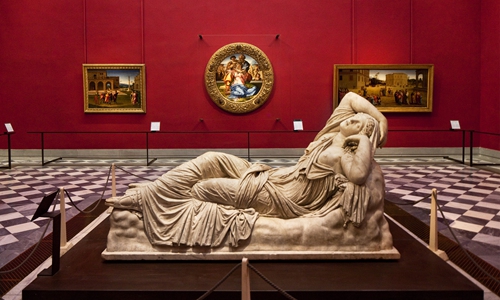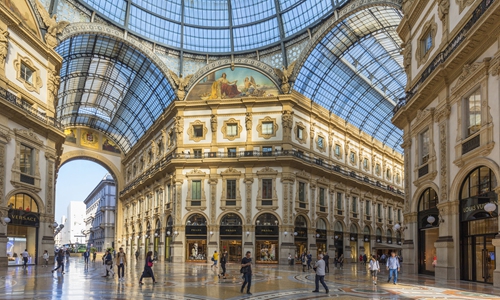Italian museums adopt online options amid coronavirus crisis
Source:Xinhua Published: 2020/5/7 13:38:40

Uffizi Gallery in Florence, Italy Photo: IC

The Pinacoteca di Brera in Milan, Italy Photo: AFP
Most of Italy's nearly 4,000 museums are set to reopen this month, several weeks after they closed at the start of the national coronavirus lockdown on March 10. But for most tourists, seeing some of the world's greatest cultural treasures - even months after museums reopen - will require a virtual tour.
Last week, Italian Prime Minister Giuseppe Conte announced a stage-by-stage easing of national lockdown rules. The first part of the so-called "Phase Two" starts Monday, allowing parks, factories, and building sites to reopen.
Two weeks later, that is May 18; museums will be allowed to reopen.
Initially, the number of visits is expected to be small. Last week, Minister of Tourism Dario Franceschini said he did not expect foreign tourists, who represent the bulk of the country's tourism industry, to return to Italy in large numbers until 2021.
Additionally, social distancing rules will reduce the number of visitors who can visit any given museum at any one time.
Florence's sprawling Uffizi Museum, for example, will only allow 450 visitors into the museum at a time, half its usual number.
In Rome, the full exhibit to mark the 500th anniversary of the death of Renaissance master Raphael will most likely end up shortened to just 15 days, since most of the works loaned to it must be returned. The exhibit, the most extensive collection of Raphael's work ever gathered in one place, had been scheduled to run from March 5 to June 2; however, it was forced to close its doors just days after it opened.
Other museums say they'll only allow tourists in by reservation or through the use of shifts.
But many of the country's most celebrated museums are already open 24 hours a day for increasingly sophisticated virtual tours.
The Pinacoteca di Brera in Milan, for example, had a well-developed virtual presence even before the lockdown. But the museum's director, James Bradburne, said in an interview that after the museum closed he had staffers working from home focused on further improving the museum's high-definition digital presence.
"I have always thought that a museum was more than what it is hanging on the walls, and so a virtual experience must be more than just posting a digital image of the artwork," Bradburne said. "A museum is about the experience, and our task has been recreating that experience online."
Among the initiatives: an interactive tour allows "visitors" to move around the museum as they would in person. Additionally, the museum posts videos of staffers describing their favorite works of art, and there are storytelling initiatives in multiple languages. It seems to be working: Bradburne said that daily visitors to the museum's site rose so quickly that the museum had to change its server.
Dozens of other Italian museums and cultural sites - ranging from the Uffizi in Florence and the Museum of Modern Art in Bologna to the Palazzo Ducale in Venice and the Colosseum in Rome - have adopted a similar approach. Even the Scuderie del Quirinale has set up a virtual tour for the Raphael exhibit aimed at those unable to visit.
"When we closed, we started planning a rich schedule of online initiatives on our website and on social media, including a virtual tour and a backstage video," Mario De Simoni, president of the Scuderie del Quirinale said in an emailed statement.
Though the focus will turn back toward live visitors after May 18, Bradburne, De Simoni, and others said a focus on sophisticated virtual access to museums would continue far beyond the lockdown and the months of limited museum access to follow.
Luca Desiata, an art curator and a management professor at Rome's LUISS University, said that focus would represent a challenge for some. "Museums have to make an effort to do virtual tours the right way," Desiata told Xinhua. "It's an expensive, serious process that is difficult for smaller museums."
Patrizia Asproni, president of ConfCultura, an association of museum operators, said that a new focus on virtual tours should be part of a broader effort to make access to culture easier.
"After things return to normal I think we will have to rethink the way we look at museums," Asproni said in an interview. "It's no longer enough to show something. A work of art or of historical significance has to be explained in a compelling way, and it has to be made available to as many people as possible."
Newspaper headline: Virtual approach
Posted in: CULTURE & LEISURE